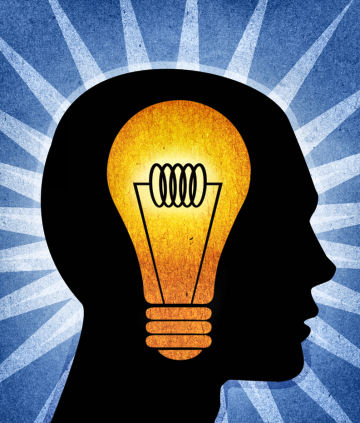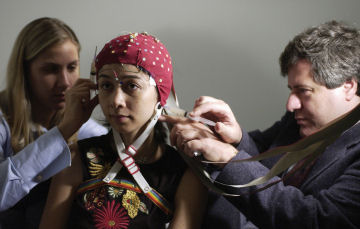Road to Eureka!
Insight may lie at the end of a chain of neural reactions
Sudden bursts of insight that, with no warning, provide unexpected, novel solutions to thorny problems are the stuff of legend. Consider Archimedes, the great ancient Greek mathematician and scientist.


The story goes that Archimedes was stumped by a request to determine whether the king’s new crown, shaped like a laurel leaf, contained solid gold or a mix of gold and silver added by a dishonest goldsmith. Archimedes couldn’t follow normal procedures by melting the crown down and measuring its density as a cube. What to do?
While taking a bath one day, the scholar noticed the level of water rise as he immersed himself. A thought flashed through his mind: This effect could determine the crown’s volume and after he weighed it, its density. Then, he could determine whether the crown included cheaper, less-dense metals than gold. Excited, Archimedes ran through the streets naked, shouting “Eureka!”—Greek for “I have found it!” Pedestrians who glimpsed euphoric Archimedes in his birthday suit probably thought he had lost it.
In the past 100 years, psychologists have occasionally explored the nature of “Eureka!” experiences, sometimes called “light-bulb” or “Aha!” moments. Experimenters can’t isolate and analyze great leaps of insight, like the one attributed to Archimedes. But scientists hope to untangle the mental precursors of far humbler discoveries, such as divining a new route home after encountering a traffic jam or having the solution to a word problem pop into one’s head.
In recent years, insight research has entered a charged new realm. Investigators now track electrical activity in the brain linked to “Aha!” moments. Brain scanners work too slowly to track split-second neural gyrations that precede such revelations. Instead, volunteers wear nets of electrodes over their heads. These studded caps measure electrical responses that flicker and flare across the brain’s surface as individuals contemplate difficult word problems.
“Using brain data, we can develop a fine-grained analysis of the insight process,” says neuroscientist Mark Jung-Beeman of Northwestern University in Evanston, Ill.
Findings remain preliminary, but important themes are emerging. First, distinctive forms of electrical activity in the brain precede “Aha!” moments and may pave the way to true insights. Second, sudden mental breakthroughs depend on widening the scope of one’s attention from a few obvious but unsuitable choices to an extended network of possibilities. As attention expands, diverse pieces of knowledge can be connected to a taxing problem.
This process proceeds unconsciously as a problem solver lets promising candidate solutions percolate in the mind. Eventually, a solution pops into awareness, as if it came out of nowhere.
“If Archimedes had consciously monitored his own thoughts in the bath, he never would have shouted ‘Eureka!'” says neuroscientist Joydeep Bhattacharya of Goldsmiths, University of London in England.
Impasse or fail
Bhattacharya’s assertion stems from a neural study of insightful problem solving that he co-authored in the Jan. 23 PLoS ONE. The investigation identified the brain activity that arises during four generally accepted components of insight, which have been studied for more than 60 years.
A mental impasse occurs first. In this frustrating state, a person gets stuck on an unsuitable approach to a problem or on a few obvious but dead-end candidate solutions, can’t think of anything else, and, temporarily, gives up.
Next comes restructuring, a mental transition from an intense focus on unusable concepts or information to a broader consideration of potentially relevant knowledge. Many researchers regard restructuring as the unconscious retrieval and recombination of long-term memories.
Deeper understanding follows. A more appropriate grasp of the problem and its solution, still lurking outside awareness, elicits an intuitive feel for the answer.
Finally, the correct answer leaps into consciousness without warning and triggers a feeling of “Aha!”
Bhattacharya explored these stages in 21 adults, ages 19 to 35. Each volunteer wore a cap fitted with 32 electrodes. Participants tried to solve 36 word problems, each within 45 seconds. Problems consisted of three test words, such as back, clip, and wall. Individuals had to generate a word that forms a compound word or phrase with all three test words. In this case, the word paper solves the problem, as it forms paperback, paperclip, and wallpaper.
Those who reached a mental impasse, described by the experimenters as “you feel you cannot proceed” or “you just don’t know what else to think of,” received a hint. Hints contained one or a few letters from the answer, such as “p_ _ _ _” or “p a _ _ r.”
After providing a solution, with or without hints, participants described whether they changed their approach to the problem at some point or had otherwise experienced restructuring. They also rated the extent to which the solution appeared abruptly, like the “flashing of a light bulb.”
Electrode recordings indicated that periods of mental impasse consisted of strong, low-frequency electrical activity in brain regions previously associated with a selective focus on one or a few items. This finding fits the idea that attending too closely to certain material can block efforts to find a correct solution, Bhattacharya says.
Low-frequency neural responses associated with reports of restructuring emerged roughly 1.5 seconds before participants suddenly thought of the correct word. This activity appeared at the front of the right side of the brain, an area implicated in organizing knowledge and using it to make plans. Substantially weaker activity in the same region characterized cases of restructuring that led to incorrect answers.
However, volunteers reported experiencing little or no restructuring before coming up with more than half of their insightful solutions without a hint. In many cases, those insights occurred within a few seconds of seeing a problem and may not have depended on restructuring. It’s also possible that the step was unconscious and simply eluded subjects’ awareness.
After receiving hints, most participants cited a keen perception of their own restructuring efforts but rarely experienced “Aha!” moments as they generated new solutions. Consciously monitoring one’s own thoughts during problem solving apparently squelches the four-step insight process, Bhattacharya suggests.
“The ‘Aha!’ experience mainly occurs because you’re minimally aware of what you’re thinking as you try to solve a problem,” he says.
A narrow range of high-frequency activity accompanied deeper understanding and appeared a fraction of a second before sudden insights. These responses appeared in right-brain areas involved in sorting through verbal and spatial information. At the moment of “Aha!” this high-frequency activity broke into two distinctive clusters within the same neural territory. Non-verbal tasks may activate different brain areas during insight, Bhattacharya says.
Bhattacharya’s study “is striking in the degree to which it complements prior behavioral evidence for four stages of insightful problem solving,” remarks psychologist Jonathan Schooler of the University of British Columbia in Vancouver.
Antecedents of Aha!
The new study adds to findings from brain experiments jointly directed by Northwestern’s Jung-Beeman and psychologist John Kounios of Drexel University in Philadelphia. However, Jung-Beeman and Kounios slice up the neural precursors of insight in their own way.
In a 2004 report, they measured electrical activity in the brain that accompanies either “Aha!” experiences or consciously generated solutions to word problems such as those used by Bhattacharya. About a third of a second before reporting sudden insights, volunteers displayed a burst of high-frequency electrical activity in a right-brain region that integrates distantly related pieces of verbal information. This response, unique to “Aha!” solutions, allowed individuals to see connections among words that previously eluded them, the researchers suggest.
A 2006 investigation moved back from the moment of insight to the brief period of mental preparation before a person views a word problem. In the 2-second span between seeing a cue that a problem was coming and seeing the problem appear on a computer screen, volunteers who generated “Aha!” solutions displayed distinctive neural responses. Activity in certain left- and right-brain areas reflected readiness to look for easily accessible words and, if no solution emerged, to broaden attention and consider a diverse array of words, according to the investigators.
Participants who solved problems through conscious deliberations exhibited preparatory brain activity that suggested a singular focus on whatever was about to appear in front of them.
The road to “Eureka!” may start even before the mental preparation period, as a person sits quietly and does nothing at all, Kounios suggests. In a recent Neuropsychologia, he and his coworkers report that the brains of people who later use insight to solve word problems already display “resting-state” electrical activity associated with a broadening of attention. This activity appears in right-brain areas that identify distant connections among words and verbal concepts.
In the new study, deliberative thinkers show resting-state activity associated with paying close attention to a few items. These responses primarily occur in the left brain.
It’s not clear to what extent genes or previous experiences shape insight-related differences in resting state activity, Kounios notes. Twin studies suggest these brain responses remain largely stable over time, reflecting genetic influences.
“I suspect that there is a genetic set point for creative and insightful thinking that differs from one person to another,” he says.
Heading intuit
Kounios and his colleagues see value in Bhattacharya’s analysis, but they regard his findings as incomplete. In particular, Kounios contends, the London researcher failed to account for preparatory brain responses among his volunteers as they expectantly waited to see word problems.
For his part, Bhattacharya asserts that Kounios and his coworkers have yet to study distinctive elements of insightful problem solving. Neural findings that derive from volunteers’ self-reports of experiencing either insight or deliberation say little about underlying mechanisms leading to either outcome, Bhattacharya holds.
Psychologist and long-time insight investigator Robert J. Sternberg of Tufts University in Medford, Mass., says recent brain studies of “Aha!” events provide intriguing new perspectives. But no experiment to date “tells us how people actually have insights, or what they can do to improve their insight skills,” Sternberg says.
Bhattacharya and Kounios agree that further work needs to examine whether mental training—such as meditation or biofeedback—fosters brain activity associated with insightful problem solving.
The relationship between insight and intuition also remains largely unexplored. In 2007, a team led by neuroscientist Ruediger Ilg of the Technical University of Munich in Germany used functional magnetic resonance imaging to study brain activity in volunteers making intuitive judgments. Ilg defines intuition as an effortless evaluation of complex situations.
Volunteers viewed pairs of three-word sets, one of which had a solution word that formed a compound word or phrase with each test word. Participants frequently identified the set that had a solution word within a few seconds, though they could not name the solution word itself in that time.
These intuitive judgments activated brain areas similar to those linked to deeper understanding by Bhattacharya and to readiness for insightful problem solving by Kounios’ group.
The unconscious process of intuition sometimes yields sudden, consciously experienced insights, in Ilg’s view.
For now, a consensus about the neural road to “Eureka!” remains out of reach. “Insight lies at the core of human intelligence,” Bhattacharya says, “but it’s still uncharted territory for brain scientists.”